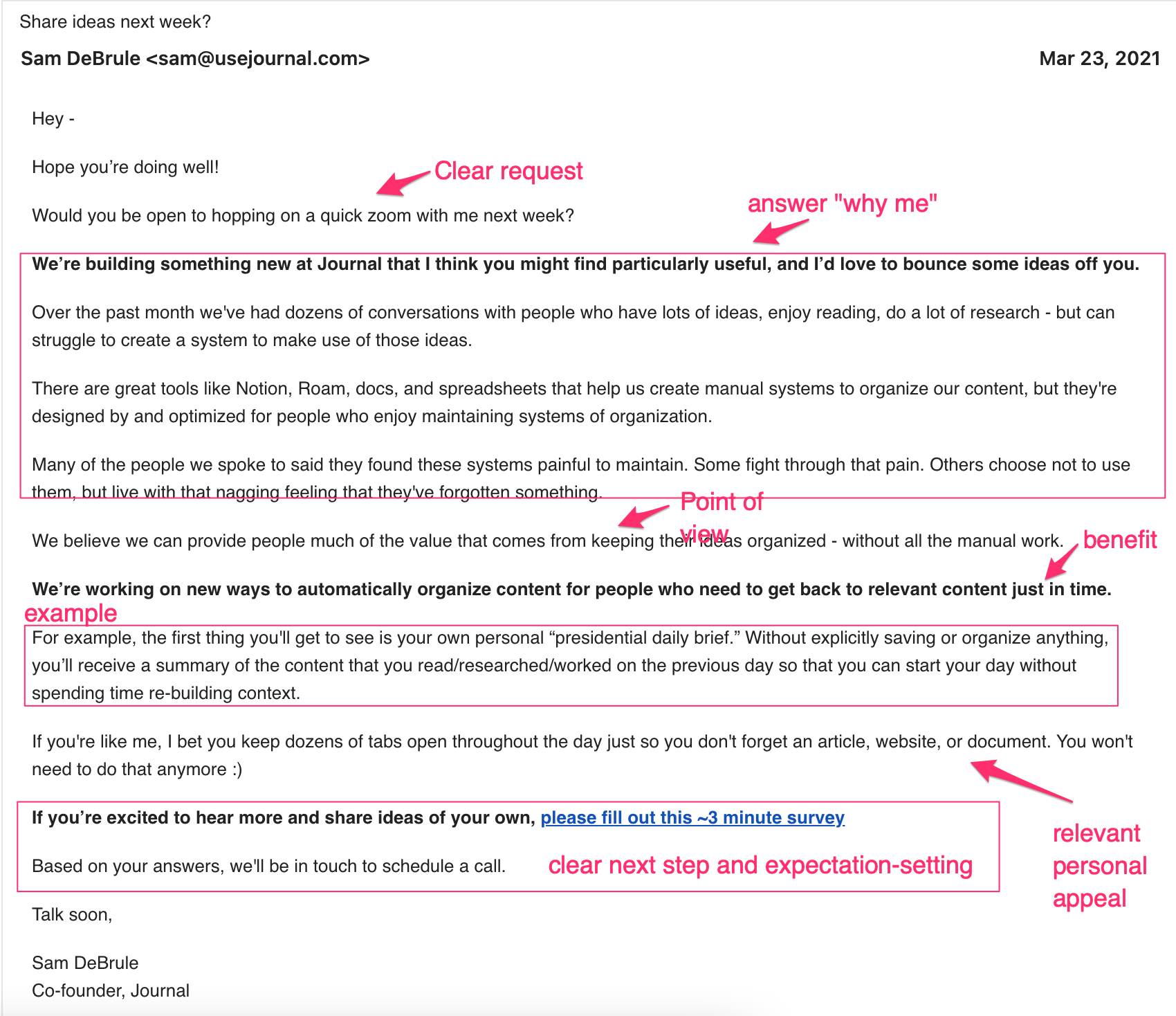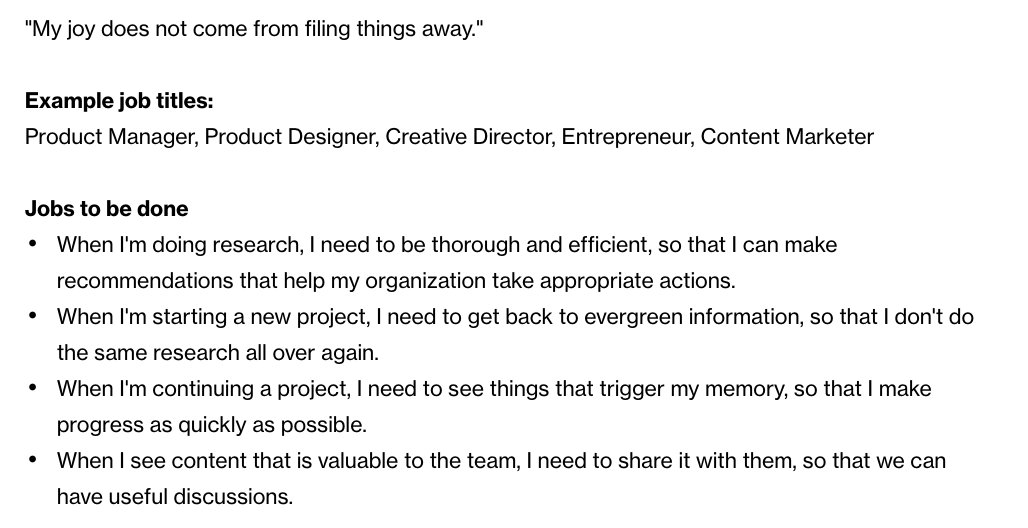The process I used for 200+ user research interviews
I've run over 200 user research interviews for Journal.
A well-known product leader stopped me after a recent call and said, "I'm going to steal your interview questions for my team. Can you walk me through the rest of your process?"
So here's what I've learned about user research across many different projects. You'll see those interview questions, my outreach email, tool recommendations, and more.
Whether it's your first foray into user research for a project or at an early-stage startup, or even at a larger company where the process isn't baked in as a practice yet — it's easy to get started.
Start with a point of view
Start with a point of view on the problem you're solving with your product — the more opinionated the better.
Our point of view at Journal? As founders of a creative research tool, Samiur Rahman (CEO and co-founder) and I had a hypothesis that instead of appealing to everyone — including people who love organizing — we should be focusing on people who want the results of organizing but hate the tedious process.
4/ A lot of us want the fruits of organizing, not the process. We don't want to do the manual labor because it's tedious for us. But just because you don't like gardening, doesn't mean you shouldn't have fresh vegetables! pic.twitter.com/xM8pJqK4BK
— Samiur Rahman (@samiur1204) March 12, 2021
This point of view is a touchstone — making the right people easier to find, and have them be more willing to talk to you too.
Set a goal for your interviews
Plan for interviews with an end goal in mind. This goal informs which questions to ask, teammates to involve, and how to structure notes.
Our recent goal was to create a user persona to guide our product and marketing. Here's a peek at what we ultimately created:
For many user research goals, there will be examples for what you want to end up with. We couldn't have created our persona without examples from GitLab's handbook.
Identify your audience
Create a list of people who you think experience the problem you've set out to solve — even better if they like you. Start with friends and then move onto others who might want to talk. We included current and former users, members of our Slack community, and readers of our newsletter.
Then narrow your list to help focus your efforts. Prioritize people that you can help soon, as they'll share more actionable feedback. Our outreach message also included a survey about productivity habits to help qualify our list and refine the potential audience to be more relevant for what we're building. Recently, we were looking for feedback on what will eventually become an iOS app, so we removed Android users from our interview list.
To identify our potential interviewees and keep track of everything, we used:
- Airtable to manage contacts
- Samiur connected Zapier to Airtable to add job roles from Clearbit data
- Product usage data from Intercom
- Personal habit data collected via a Typeform survey.
6 Elements of effective outreach
A good message gets people excited to talk. These are the elements I make sure to include that I've seen work well to get people on a call — including those who I'd never had any interaction with before.
- make a clear ask
- answer "why me"
- explain your POV
- state the benefit
- use an example
- make a personal appeal
Here's the message we sent:

Create questions to seed the conversation
When you're drafting questions, keep your interview goal in mind and asking thing to help paint a full picture of the person you interview.
- When do they do things? How?
- What frustrates them? Why?
Here are the questions we prepared for our use persona interviews:
- What about email resonated with you?
- Can you talk to us about what you're responsible for in your job?
- How do you accomplish these things?
- Morning routine?
- What sort of research or information / content collection do you use to do this?
- When do you do this gathering? On what device? Passively or intentional?
- What frustrates you about this process?
- How do you collaborate?
- Process to remind yourself of things the next day. What doesn't work for you with that process? What in that gives you worry / anxiety?
- If you had a personal research intern to help curate content, what would they do for you?
- Anything we should be asking that we didn't
- Any teammates / friends you think would get value from this?
We want people to be comfortable, so they'll share more openly. Show product mocks - they're a great way to get the interviewee to ask you questions that reveal their true motivations and frustrations.
And really, the goal is not to stick to the prepared questions every time. They are there if you need to keep the chat going. They're really more of a starting point to create a conversation that flows naturally, tailoring to the person that you're actually interviewing.
That's when you're going to the real, authentic, non-rote responses. That's where you'll start having unique insights and takeaways that you wouldn't have by just sending an email or survey out with questions to answer.
The starting point might be exploring the pain point that your internal team experiences around the chosen problem. The research interviews start to validate and add to that store of knowledge. If you don't have the luxury of building a solution to a problem that you experience first-hand, seek out stories from individual people you interview and start using that as seeds to explore in conversations with other similar personas down the line.
Share the knowledge so you can act on it
Take notes. Write. Everything. Down. You'll forget what was said, and you won't actually go back and watch video recordings. With notes, you can share more easily with your team and be able to re-use quotes from the calls over and over.
Involve your team. Invite teammates to interviews, and ask them to take notes and jump in when questions spark in their mind. It was important for me leading the interviews that I wasn't typing away throughout the conversation, because the goal was to have it as natural a flow as possible. A designated note-taker would also hear things slightly different and be able to take notes in a way that would resonate better with people who weren't there in real-time.
One of the most fruitful parts of involving teammates is talking immediately after the interview to discuss the call and what stood out. Listening to feedback directly from users is the best way to build empathy — and talking about it together live and fresh off the conversation gave us a different level of excitement. These collective discussions turned the interviews into things that we acted on as a team.
If you're hearing things repeatedly, start updating your marketing site copy. We always try to refer back to specific things people said in the interviews — and trying them out on different channels and mediums. The interviews help us create a common vocabulary and the next step is to use that vocabulary to guide whatever content or message you need.
Iterate!
Lastly, iterate on your process. Tweak survey questions. Edit your outreach messages. when responses to cold DMs start to look like this, you're onto something:

Doing user research is important because we have really strong opinions or ideas in our head. It never ceases to surprise me how off-base our thinking is — like when we put out a new feature, for example, and think it will be totally intuitive. I've seen, time and time again after testing such ideas with people externally, that we did not fully understand the problem or envision the solution in a way that actually connects to the reality of the people that we're trying to help.
The reason that product leader wanted a walkthrough of my process was that we talked about a problem that felt very real to him. The questions on the call I had with him kept sparking thoughts and realizations of moments in his life that he hadn't necessarily had the opportunity to express.
User research gives us a more full picture of the people we're serving, their needs, how our product helps them — and be able to put everything into actionable words.
Go and do it!
This post is in adapted and expanded version of my Tweet thread.


